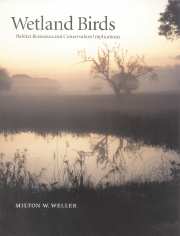Book contents
- Frontmatter
- Contents
- List of plates
- Preface
- Acknowledgments
- 1 Introduction
- 2 Wetlands: what, where, and why
- 3 Major groups of birds that use wetlands
- 4 Water and other resource influences
- 5 Foods, feeding tactics, strategies, and guilds
- 6 Bird mobility and wetland predictability
- 7 Other behavioral and physical influences on wetland living
- 8 Spatial and structural patterns
- 9 Habitat dynamics: water, plant succession, and time
- 10 Population consequences of wetland abundance and quality
- 11 How birds influence wetlands
- 12 Conservation implications
- 13 Measures of bird habitat use and quality
- 14 Current status and some conservation problems
- 15 Conservation and management strategies
- 16 Outlook
- 17 Epilogue
- Appendix 1 Scientific names of birds and bird groups
- Appendix 2 Scientific names of animals and animal groups other than birds
- Appendix 3 Scientific names of plants and plant groups
- Index of birds and bird groups
- Subject index
9 - Habitat dynamics: water, plant succession, and time
Published online by Cambridge University Press: 02 October 2009
- Frontmatter
- Contents
- List of plates
- Preface
- Acknowledgments
- 1 Introduction
- 2 Wetlands: what, where, and why
- 3 Major groups of birds that use wetlands
- 4 Water and other resource influences
- 5 Foods, feeding tactics, strategies, and guilds
- 6 Bird mobility and wetland predictability
- 7 Other behavioral and physical influences on wetland living
- 8 Spatial and structural patterns
- 9 Habitat dynamics: water, plant succession, and time
- 10 Population consequences of wetland abundance and quality
- 11 How birds influence wetlands
- 12 Conservation implications
- 13 Measures of bird habitat use and quality
- 14 Current status and some conservation problems
- 15 Conservation and management strategies
- 16 Outlook
- 17 Epilogue
- Appendix 1 Scientific names of birds and bird groups
- Appendix 2 Scientific names of animals and animal groups other than birds
- Appendix 3 Scientific names of plants and plant groups
- Index of birds and bird groups
- Subject index
Summary
Water variability
The dynamics of water over time, whether seasonal, annual, or longer term, dictates the chemical and physical character of wetland water, the resulting vegetation, and the use of wetlands by birds and other aquatic or semiaquatic life. Numerous authors have summarized the consequences of variable water regimes on vegetation, plant succession, and size and depth of various types of wetlands (Bellrose, Paveglio and Steffeck 1979, Chabreck 1988, Golet and Parkhurst 1981, Gosselink 1984, Kantrud, Krapu and Swanson 1989, Kushlan 1989, Stanley, Fisher and Grimm 1997, Weller and Fredrickson 1974). Here we examine the general patterns of water influences on vegetation and the physical aspects of the wetland habitat that influence bird use. Examples also are given that show the similarities of these patterns worldwide.
Temporal changes in wetland vegetation
Because of the importance of vegetation structure and food resources in attracting a diversity of birds, we must focus on some of the factors that influence (i) the establishment of the plants in wetlands, based on their life-history strategy; (ii) the influence of water depths and substrates on plant survival and reproduction; and (iii) the dynamics of plant species and vegetation patterns (plant succession or biotic change). Birds respond to many of the same environmental influences as do the plants and, thus, are intimately linked with the entire succession process, regardless of the time frame.
Water is the major influence on wetland habitat variability, often changing seasonally and from year to year.
- Type
- Chapter
- Information
- Wetland BirdsHabitat Resources and Conservation Implications, pp. 145 - 164Publisher: Cambridge University PressPrint publication year: 1999



